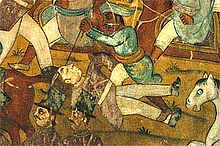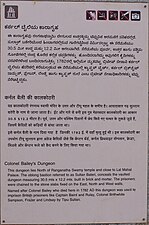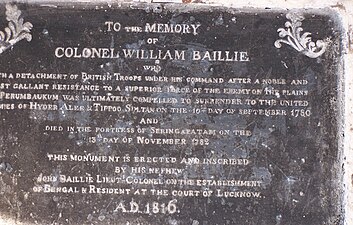Battle of Pollilur (1780)
| Battle of Pollilur | |||||||
|---|---|---|---|---|---|---|---|
| Part of the Second Anglo-Mysore War | |||||||
 Illustration of the battle | |||||||
| |||||||
| Belligerents | |||||||
|
|
| ||||||
| Commanders and leaders | |||||||
|
|
| ||||||
| Strength | |||||||
| 11,000[1] | 3,853[2] | ||||||
| Casualties and losses | |||||||
| Unknown |
2,016 killed 1,000 captured [3] | ||||||
The Battle of Pollilur (a.k.a. Pullalur), also known as the Battle of Polilore or Battle of Perambakam, took place on 10 September 1780 at
Background
Tipu prevented Baillie from joining another EIC force, consisting of two companies of European infantry, two batteries of artillery, and five battalions of native infantry from
Battle
Baillie's men, suffering desertions and uncoordinated leadership, formed a defensive square on a patch of high ground, with William Baillie leading a final stand. Cut off from both Conjeevaram and the stronghold of Fort St. George in Madras where a larger EIC force remained encamped, Baillie's men were caught in a
Aftermath

Baillie and many of his officers were captured and taken to the Mysore capital at Seringapatam. After British reinforcements from Calcutta arrived, Eyre Coote was able to stabilise the situation and counter-attack. A second battle was fought a year later in the same area.
Rockets
The
Gallery
-
Tipu Sultan commissioned The Battle of Pollilur for the Daria Daulat Bagh to monumentalize his victory; early 19th-century, gouache on paper, 10 sheets of paper on canvas, mounted on restoration fabric, 962 × 200 cm, private collection.
-
Baillie Dungeon, Seringapatam (2004)
-
Narrow Passage to Colonel Baillie's Dungeon, Seringapatam (2004)
-
Memorial Plaque at Baillie Dungeon,Seringapatam
-
Signboard at Baillie Dungeon,Seringapatam
-
Old Signboard at Baillie Dungeon,Seringapatam
-
Stones to which prisoners were tied, Baillie Dungeon,Seringapatam
-
William Baillie Memorial, Seringapatam
-
Plaque of the William Baillie Memorial, Seringapatam
See also
References
- S2CID 161374846.
Captain Munro noted: 'Around two or three thousand horse and rocket-men kept hovering round our main army, in order to conceal his enterprise from us'.
- .
As late as 1780, following the disastrous British defeat by Tipu Sultan of Mysore at the Battle of Pollilur, 7,000 British men, along with an unknown number of women, were held captive by Tipu in his sophisticated fortress of Seringapatam.
- ISBN 1-4000-4167-8.
Some three thousand Company soldiers were killed, while Baillie and two hundred Europeans, fifty of them officers, were carried off to Seringapatam in chains.
- ^ a b Ramaswami, N.S. (1984). Political History of Carnatic under the Nawabs. New Delhi: Abhinav Publications. p. 225.
- ^ "The Battle of Pollilur: Revisiting the Footnotes of History". The Wire. Retrieved 9 September 2022.
- ISBN 9788131300343.
- ^ "The Battle of Pollilur: Revisiting the Footnotes of History". The Wire. Retrieved 9 September 2022.
- ^ Roddam Narasimha (1985). Rockets in Mysore and Britain, 1750-1850 A.D. Archived 3 March 2012 at the Wayback Machine National Aeronautical Laboratory and Indian Institute of Science.
External links
- "Battle of Pollilur (1780)" Archived 23 February 2018 at the Wayback Machine - A detailed historical analysis (and its importance in world history)
- Tipu Sultan website
- Wilson, W. J. History of the Madras Army, Volume 2









